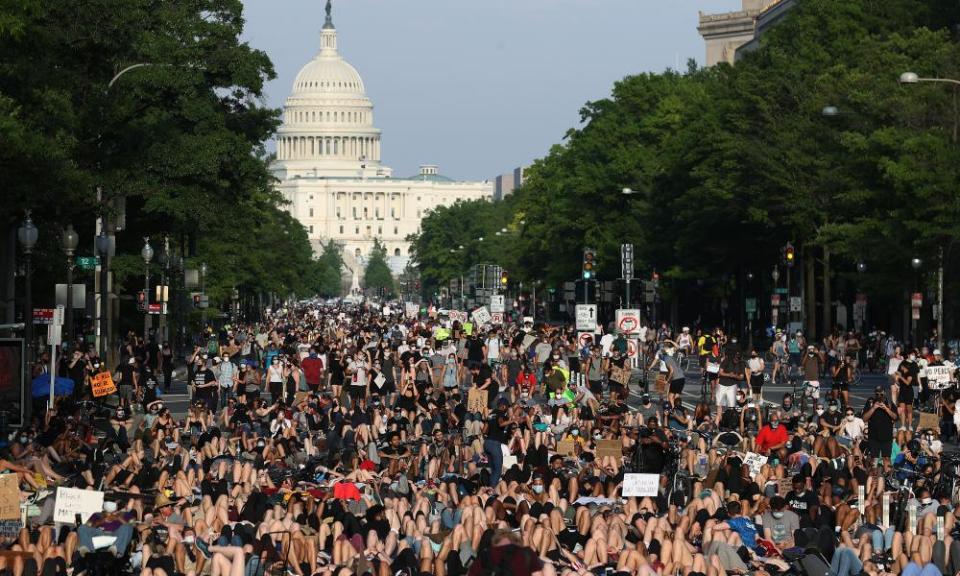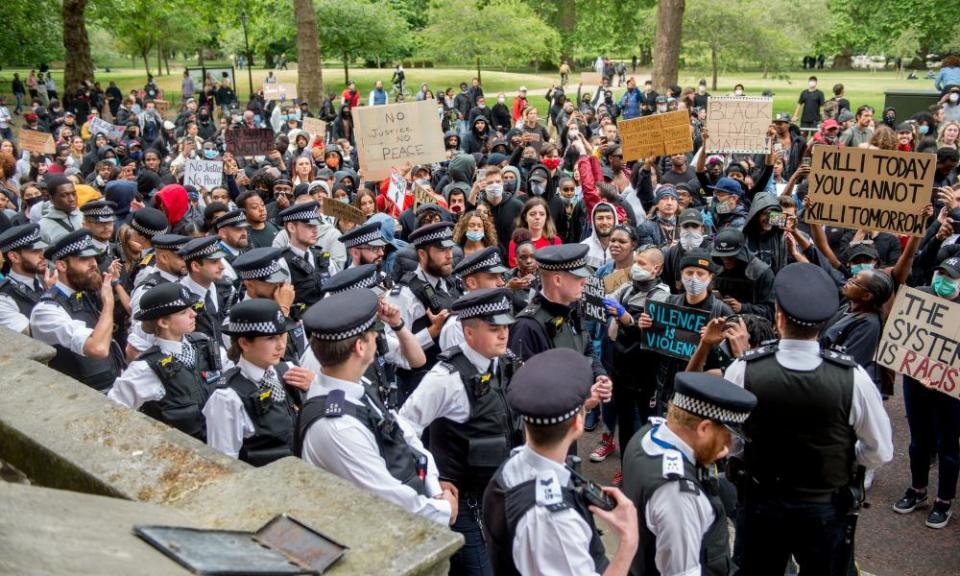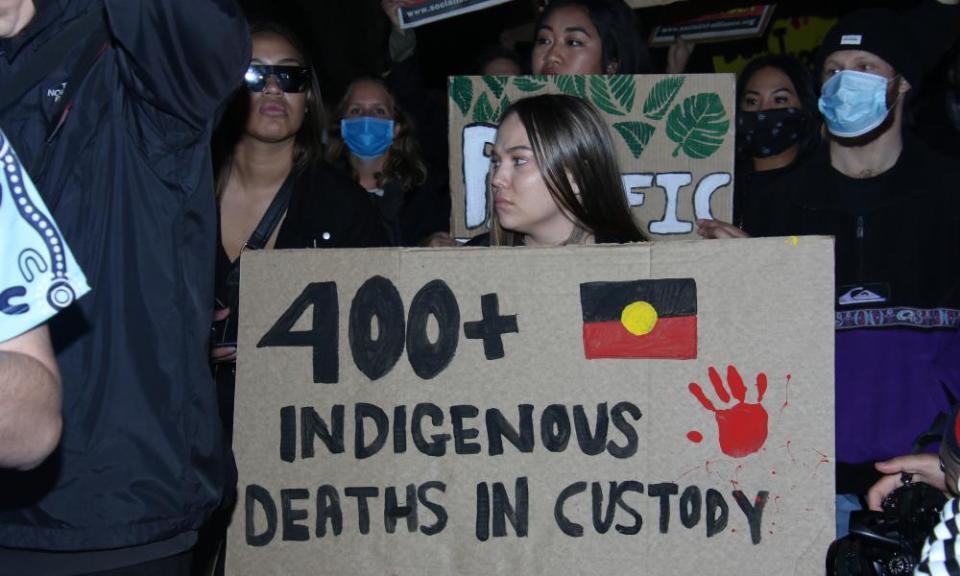George Floyd: reporting on a week of fury, pain and deep solidarity

Chris McGreal, Guardian US reporter, in Minneapolis
This has been by far the most serious unrest I’ve covered in the US.
I was in Ferguson six years ago where the protests looked more dramatic on the television than they actually were, with a few buildings looted and burned, and confrontations with the police a staged nightly ritual over the same few blocks.
Minneapolis was on a different scale, both in the depth of anger and the levels of protest and destruction. Many thousands turned out to lay siege to the police station in the precinct where George Floyd was killed before they stormed and burned it. Many thousands more marched in different parts of Minneapolis and St Paul before the protests spread across the country.
For two nights in a row, the police evaporated – leaving a huge area around about three miles of a main shopping thoroughfare, Lake Street, under the control of protesters, looters and arsonists. Hundreds of businesses had their windows smashed, were looted, or were burned.
The scale of the demonstrations and destruction reflected the scale of the anger.
That seemed to me in part because of the video of George Floyd’s death was so clear-cut and painful. It’s telling that so few people have tried to justify the former police officer Derek Chauvin’s kneeling on Floyd’s neck for nearly nine minutes as the life drains out of him, unlike the many who spoke up in support of the officer who shot Michael Brown in Ferguson.
But that video also added to a sense of the frustration at yet another killing of an African American man by the police, and that so little seems to change even with the rise of Black Lives Matter. The way that Chauvin looks into the phone cameras, knowing he is being filmed, and kept his knee on Floyd’s neck regardless of his pleas and cries for his mother seemed to symbolise the contempt of the police for the movement.
As a result, the more peaceful demonstrations drew people who do not normally protest. I even met a few Republicans who were horrified by what they saw on the video and thought the time had come to stand up.
Through all of this, social distancing broke down completely. Riots in different times usually meant protesters tied bandanas or T-shirts around their faces to shield their identities. In 2020 everyone had a mask readily to hand. There were times when it looked as if the local medical school was charging the police accompanied by particularly fashionable rioters in designer masks.
In a sign of our times, reporters found themselves not only hit with baton rounds and teargas by the police when it was clear they were shooting at journalists, but facing physical threats from some among the protesters. These tended to be young men, both white and black, who see the media as part of the conspiracy.
And if you look like me (ageing, no hair), there’s the occasional person who imagines you are a police spy and lets you know with varying degrees of hostility. Although this was pretty easily dealt with the moment they heard my accent.
Aamna Mohdin, Guardian reporter, in London
The killing of George Floyd took place thousands of miles from the UK, but the anger and pain that sparked mass protests in the US has resonated deeply across the Atlantic.
Last weekend, protests sprung up sporadically in Cardiff, London, Manchester, and Nottingham to state clearly that “Black Lives Matter” in the UK as well. The protesters, the vast majority of whom were under 30, chanted: “No justice, no peace, no racist police” and “the UK is not innocent”, in a demonstration that was largely organised through word of mouth and social media away from established anti-racism groups. Teenagers, who said they had grown up with videos of black people dying on their timelines, shouted: “Enough is enough.”
They carried hundreds of handmade signs and called out the names of those in the UK that have died at the hands of the police, including Mark Duggan. Though coronavirus is invisible, the disproportionate impact the pandemic has had on the black and minority ethnic community in the UK was another source of anger and frustration among demonstrators.

Julian Borger, world affairs editor, in Washington DC
There were different currents inside the crowds outside the White House. The great majority were there for a protest, but there were small groups weaving in and out looking break and burn things. As long as they were in the body of the crowd, they were mostly contained, shouted down when they threw water bottles at the police.
The discipline only really collapsed when the police started to break up the protest, with short charges, flash-bang grenades and gas canisters. There is some doubt about what kind of gas it was. The police deny using CS (tear gas) but canisters of OC gas (Oleoresins Capiscum) were found at the scene, and that has very similar effects - a burning sensation in the eyes and throat.
When the crowd scattered things really fell apart. One group started to smash the entrance to the AFL-CIO union federation headquarters, while a handful tried to talk them out of it, but the vandals carried the day. They set light to one car and ran along I Street, a thoroughfare running through the commercial centre, with baseball bats, smashing every car they came to. There were no police to be seen: they and the National Guard were all massed in front of the White House with the sole focus of breaking up the demonstration. Looters were left to their own devices. The result of those tactics was angrier protesters, a licence for looters and more destruction.
In similar situations of civil unrest I have witnessed elsewhere in the world, there was a sense that being a journalist with credentials around your neck afforded some personal protection. Journalists in the melee outside the White House knew that wasn’t true here. Reporters have been targeted all over the country. It was an unnerving feeling, that a line had been crossed in the relations between the police and press. It seemed to me that the “enemy of the people” rhetoric of the president had been internalised. I think it will be hard to change that back.
Joanna Walters, Guardian US news editor, in New York
It’s unprecedented to be covering mass protests during a pandemic that has also cratered the economy - a combination of factors that has had a massively disproportionate impact on urban communities of colour in America. But it has also made reporting in the field extremely difficult. We’ve been taking a safety first approach. Despite my time being mostly taken up with editing, in the non-Covid world I would have rushed out with my notebook and phone to talk to protesters and gauge the mood in person, jostling alongside everyone. But many protesters, and police, are not wearing masks. Social distancing at the heart of the action is a hopeless aspiration and the risks of coronavirus for everyone are acute, so I’m being more cautious than usual.
Conservatives call for forceful restoration of law and order, progressives call for listening and reform. It’s hard to see a healing of divisions and any progress away from historical systemic racism and inequality in this fraught, weird election year in lockdown, infected by both a virus and violence. But there are powerful voices and ideas for change out there and we’ll make sure to elevate them and bring some hope in these tough times, too.

Naaman Zhou, Guardian Australia reporter, in Sydney
In Sydney, hundreds gathered in solidarity on a cold Tuesday night. We have our own issues with policing, and the deaths of Indigenous Australians in custody. They chanted for George Floyd, but also for David Dungay Jr. – who said “I can’t breathe” 12 times in a Sydney jail before he died in 2015 – and against the statistic that 432 Indigenous Australians have died in custody since 1991.
There was a real sense of tension. I have covered many, many protests in this exact place before. The annual Invasion Day rallies, the climate strikes. In comparison, this event had been more swiftly, and more confusingly organised. The main protest was planned for Saturday; this was more of a snap action. Police permission had been granted, we were told, an hour before the protest. Many were not sure whether it actually had been. There was a natural worry among the crowd, having seen so many people gassed and shot by police in the US. Just the day before, a local police officer had slammed an Indigenous teenager onto the ground.
But police on Tuesday were restrained, all unarmed (as most Australian police are), and the presence relatively small. The event officially concluded after an hour, but most people stayed put, wanting to be there, unsure if it was over, intent on it continuing. Impromptu speakers stood and spoke. People knelt in Sydney’s Martin Place and chanted “I can’t breathe”.
Ankita Rao, Guardian US reporter, in New York
Over the course of the last week, I’ve watched the tense interactions between the NYPD, a veritable $6bn army, and the people of New York. The protests, often dozens happening simultaneously across the boroughs, follow the same arc: a large, passionate mass of people with signs and chants who mobilize down the streets and bridges, occupying spaces normally left to cars. And then at some point, a standoff with the police. It takes so little for these to get violent -- a plastic water bottle chucked in the wrong direction, or someone on the sidewalk stepping onto the street. And then an officer will bear down, push back, pull out a baton. After that, it’s hard to say what will happen that night -- we’ve seen everything from teargas to beatings to the arrests of minors.
In New York, no one in power is held sacred -- not the mayor, not the governor. And these past few days, I’ve seen the most powerful solidarity I’ve ever witnessed on the streets of the city. People handing out food, masks and water bottles. Protestors calming each other down, burning sage and palo santo, speaking poems. Over the days the protests become more intentional, with more direction, and more conversation about what to do when the night falls. More children, more dogs, more doctors. Yesterday I spoke to some protesters who had decided, at midnight, to head home. They said they needed to save their energy. They planned to be out on the streets every day for a long time.

 Yahoo News
Yahoo News 